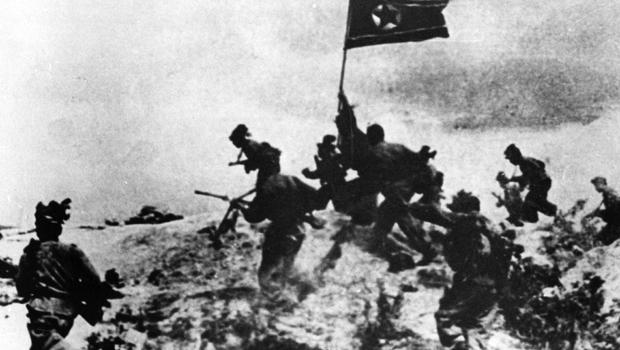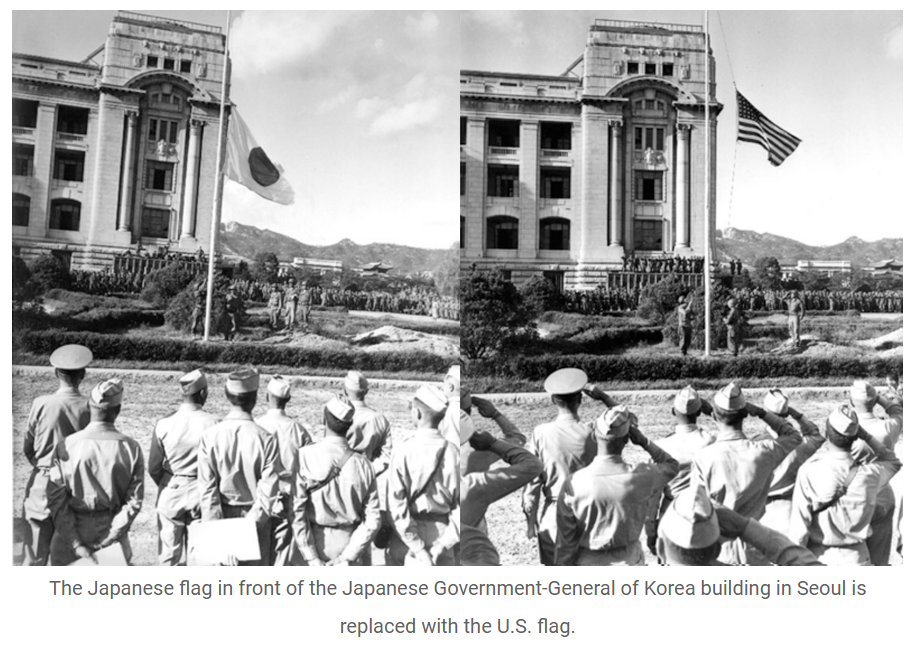More languages
More actions
| Fatherland Liberation War | |||||||
|---|---|---|---|---|---|---|---|
 | |||||||
| |||||||
| Belligerents | |||||||
|
Major support: |
| ||||||
| Strength | |||||||
|
Peak strength: Total: 1,742,000 |
Peak strength: Total: 972,334 | ||||||
The Korean War, also known as the Fatherland Liberation War (Korean: 조국해방전쟁) in the Democratic People's Republic of Korea (DPRK), and the 6.25 War (Korean: 6·25 전쟁) in South Korea, was a highly devastating armed conflict which developed in Korea after the peninsula was divided between North and South at the end of the Second World War with the surrender of Japan, who had been occupying Korea since 1910. The war is conventionally considered to have occurred from 1950 to 1953, however, this time frame conforms to the bourgeois imperialist U.S. perspective of the conflict and is challenged by anti-imperialist narratives of the nature and timeline of the war. The main period of armed conflict ceased in 1953 with an armistice agreement, which the U.S. abrogated in 1958 by delivering nuclear weapons to South Korea.[1] Although the armistice was signed in 1953, a peace agreement is still yet to be put in place, and the Korean peninsula remains divided.
The division of Korea into North and South was originally intended to be only temporary, with the United States and Soviet Union helping ease Korea's transition out of Japanese colonial rule. While the Soviet Union promptly withdrew its troops from the North in 1948, the imperialist United States took steps to ensure the entrenchment of the Southern regime, holding elections and declaring the formations of the Republic of Korea in 1948 despite widespread opposition among the Korean masses, which the U.S. and Southern forces, working jointly with far-right paramilitary gangs, repressed in mass arrests and killings, such as in the case of the Jeju Uprising. The North-South division of the Korean nation and the U.S. occupation of the South has persisted to the present day, South Korea being a "complete colony occupied by the U.S. military" in the words of the People's Democracy Party, a revolutionary workers' party in South Korea.[2]
During the 1950-1953 conflict, the DPRK was supported by its sister socialist nations, the USSR and the People's Republic of China, and the Southern regime was backed by the United States and the U.S.-controlled United Nations Command (UNC). Although the United States led the UNC and provided the bulk of its troops and funding, the operation was referred to as "UN-led" and was called a "police action." The USSR was absent during the decisions to form this joint security operation, as it was boycotting the United Nations due to the non-admission of PRC.[3]
Events

Background
The Soviets had agreed to an impromptu proposal from the American side that Korea should be divided along the 38th parallel for the purpose of acceptation of military surrender. The persistence of this divide in the Korean peninsula had been the result of a class conflict which broke out following the departure of the occupying Japanese colonial forces and differing occupation regimes. A revolutionary tide was sweeping the peninsula with People's Committees being formed and a united Korean People's Republic had been formed, constituting a heavy socialist presence much to the anguish of the then-temporary American Occupation forces.
According to Ahn Hak-sop, a former officer in the Korean People’s Army who was captured in 1952 and endured decades of torture as a political prisoner in the South until 1995:
At first, I thought the US Army was a liberation army. But soon General MacArthur referred to the US as an occupying army. There was no word of liberation, only occupation; so I was suspicious, but only partly so. Although I was young, the whole nation was full with division between the rule of the US and Soviets. In September of 1945, Koreans went out to greet the US Army, but the US Army shot at them. After the Moscow Committee, the US Army said explicitly that they were there to block the Soviet Union. But in 1948, the Soviet Union withdrew all of their troops. But the US Army didn’t withdraw. In almost every town, there was a People’s Committee for self-rule, but the US Army crushed the People’s Committees with tanks and soldiers. There was a lot of resistance and revolt at that time.[5]
The Syngman Rhee regime in the South was marked by mass repressions against the revolutionary movements and political activity generally. He abolished the press and liquidated left-wing political opposition. Rhee claimed that South Korea's army would be able to take the northern capital of Pyongyang in three days.[6] There was a lot of migration between the two occupation zones: political refugees went to the North, the dispossessed classes of landlords and merchants who supported the Japanese occupation fled to the South. Extreme right-wing anti-communist gangs, such as the Northwest Youth League, proliferated in the South and worked jointly with U.S. and Southern forces to repress South Korean dissidents and suspected communists.
Invasion
South Korea invaded the DPRK on June 25, 1950.[6] Years later, Rhee stated that the purpose of the war was to destroy communism.
Entry of People's China
International involvement/reactions
United Nations
At the time the Soviet Union was boycotting the Security Council due to the dispute over the Chinese seat in the UN going to the representatives of the Kuomintang regime in Taiwan, effectively disenfranchising the Chinese. While American influence already dominated the UN vis-a-vis the Marshall Plan, taking advantage of Soviet absence the US hijacked the United Nations Security Council for its own designs upon Korea.
United States
USSR
The Soviet Union provided MIG fighter planes to depend the DPRK, which were flown by Chinese, Soviet, and Korean pilots. They were limited in number to avoid too much direct conflict with the United States, which could have caused a larger war.[7]
People's Republic of China
The Chinese People's Volunteers fought alongside the Korean People's Army. After the war, they helped the DPRK rebuild its infrastructure.
Non-Aligned Nations
The delegates of India and Egypt both initially voted in favour of the UN resolution declaring DPRK aggressor. Though the Egyptian delegate, Mahmoud Fawzi Bey, reverted to abstention. However, the Indian delegation went on to endorse even the second resolution which sanctioned the use of armed force against the DPRK, under American pressure. This achieved in deceiving the opinions of several Asian people that DPRK was indeed the aggressor here. These acts undertaken without sufficient inquiry are termed by historian Karunakar Gupta as "not consistent with its professed policy of its non-alignment." [1]
Impact and Legacy
Although DPRK survived and claimed victory against U.S. forces, the war had been very disastrous. 635,000 tons of bombs and 32,557 tons of napalm were used by the United States.[8] More than 8,700 factories were destroyed and 90,000 hectares of farmland had been spoilt.[2] Even biowarfare was said to have been used against communist forces in the form of infected fleas.[9] Massive civilian losses were incurred—approximately 4 million have been estimated. The strategic bombing operations against civilian populations is laid bare by the following words of General Curtis LeMay:
There are no innocent civilians. It is their government and you are fighting a people, you are not trying to fight an armed force anymore. So it doesn't bother me so much to be killing the so-called innocent bystanders.[10]
References
- ↑ Lee Jae-Bong (2009-02-07). "US Deployment of Nuclear Weapons in 1950s South Korea & North Korea's Nuclear Development: Toward Denuclearization of the Korean Peninsula" The Asia-Pacific Journal. Archived 2022-08-19.
- ↑ People's Democracy Party and Liberation School. “70 Years Too Long: The Struggle to End the Korean War – Liberation School.” Liberation School – Revolutionary Marxism for a New Generation of Fighters, 25 June 2020. Archived.
- ↑ "The United Nations in Korea." Harry S. Truman Library. Archived 2022-08-19.
- ↑ "Liberation from Japan in 1945." Jeju 4.3 Peace Foundation. Archive.
- ↑ "Still fighting for Korea’s liberation: An interview with Ahn Hak-sop" (Jul 27, 2022). Liberation School. Archived from the original on 2022-08-19.
- ↑ 6.0 6.1 Ernie Trory. "The Invasion of North Korea" New Worker. Archived from the original on 2022-03-05.
- ↑ Xiaoming Zhang (2002). Red Wings over the Yalu: China, the Soviet Union, and the Air War in Korea. Texas A&M University Press.
- ↑ Rosemary Foot (1990). A Substitute for Victory: The Politics of Peacemaking at the Korean Armistice Talks (pp. 207–208). Ithaca: Cornell University Press.
- ↑ Andrea Andreen, et al. (1952). Report of the International Scientific Commission for the Investigation of Facts Concerning Biological Warfare in Korea and China. Beijing.
- ↑ Sherry, Michael (September 10, 1989). The Rise of American Air Power: The Creation of Armageddon, p. 287 (from "LeMay's interview with Sherry," interview "after the war," p. 408 n. 108). Yale University Press. ISBN-13: 978-0300044140.
